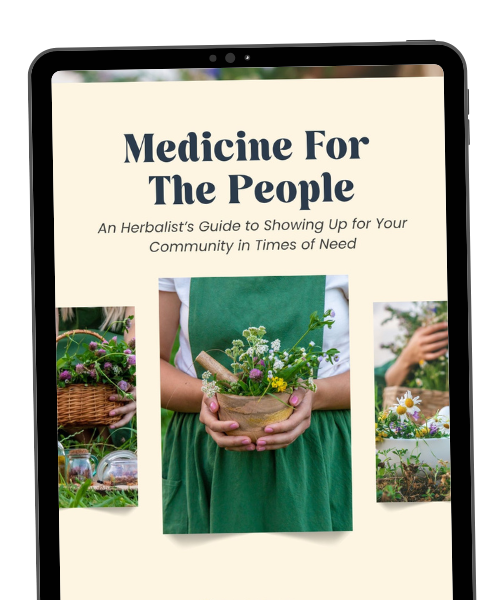Making Pain Relieving, Antimicrobial, First Aid Plant Medicine With Cottonwood Buds

Are you one of those people that absolutely hate Cottonwood trees in the springtime because you get all sniffly and watery eyes and stuffy? Well, I got some news for you. Cottonwood is actually amazing medicine. I am going teach you how you can find them and use them to ease inflammation for body aches and pains, first aid and they also happen to be great for respiratory conditions.
Cottonwood buds love to live around a river or moist area and they fall to the forest floor in late winter, early spring particularly after a good storm so it's easy to harvest these friends in a sustainable and ethical fashion.
The branches have little knuckles that almost get formed on the branches and where these little buds come up, and the little buds will just pop right off!

When you squeeze them a golden orange resin comes out and that is where the good medicine is. This is one of those times in life where I love to smell my fingers because Cottonwood buds smell absolutely heavenly!
Making Cottonwood Bud Honey
Cottonwood buds are everywhere around my house right now and these sticky gooey bunches of goodness can go really well with another sticky gooey ally, honey!
They both have fantastic antimicrobial properties to them, and as a combo can be really helpful for a first aid treatment to help speed the healing of cuts, and scrape, as well as burns too. They’ll speed the healing, and help to fight off infection at the same time.
Not only will they help to fight off the infection, but the salicylates in the cottonwood can work wonders to ease the pain of a burn or the cut too!
Both of these can work wonders when it comes time for soothing a sore throat. Now, I know I know… Many of you are probably thinking about how stuffy and sneezy you get when those fluffs of cottonwood start to fly, and trust me I get you. But, there have been studies showing that it may actually be pollen from grasses coming up at the same time.
It’s super simple to make the honey.
Grab yourself a clean jar. Harvest your cottonwood buds. Gather your honey, either from your own hives if you’re that lucky, or from a local beekeeper, and pour the honey over your buds. Let it sit for 6 months to fully infuse.
The 6 months time is perfect for back to school, and cold and flu season. You can take spoonful's of this delightful preparation, or you can even add it to your favorite tea. It will help clear stuck mucous and phlegm from the respiratory system.
The analgesic salicylates will help when it comes time to deal with the pain of a sore throat too. And, the cool thing is both honey and cottonwood act as preservatives. Really, they’re a match made in heaven, and even the bees think so!
Make a Pain Relieving, First Aid Friend w/ Cottonwood Bud Oil
Cottonwood, or Poplar trees are a member of the Willow family, which is also the Salicaceae family. They are notorious for being high in salicylates, which also happen to be a key component in aspirin, for it’s pain relieving benefits. When I first started learning about plant medicine, this was one of the first friends I was introduced to, as a topical pain relieving salve. It acts as a bit of a preservative, so it can make your oils and salves last even longer!

The sticky, heavenly scented little buds have a strong bit of resin that has some antibacterial properties that help to create a protective barrier from bacteria and fungus. Knowing this helps us to know cottonwood as a great first aid salve or oil when it comes to cuts, scrapes burns, and scratches. It’s also shown to have some cell renewing properties too that can help speed the healing of skin. So, as a first aid topical, it can help alleviate pain, fight infection, and speed the healing process. Bonus of all bonuses!
To make the oil, just gather your buds, place them in a jar, and pour your oil on top.
Put Cottonwood Buds into a clean jar, filling it just over halfway. Pour oil of your choice* over them to the top. Close jar, label it, and let infuse for at least 4 weeks, and up to a full year.
You can also place it in a warm water bath to make the infusion process happen even faster, 1-3 days. Make sure you don't allow your oil to get over 110 degrees, so you don't burn off the medicinal properties and the cook the oil.
*Organic Olive, Sunflower, Almond or other preferred carrier oil
Cottonwood Bud For Sore Throats, & Excessive Phlegm
Cottonwood bud tincture can do a really wonderful job of creating more mucosal protection for the respiratory tract. Particularly if you've got that dry, really hot sore throat kind of thing going on, it can also be really, really nice if you're really phlegmy and congested and you just can't breathe and can't get that kind of stuff up. Cottonwood buds are going to get all of that gnarly, nasty phlegm out of your body. And while the buds are most prevalent in the middle or the end of winter or very early spring, when you tincture them, you're able to keep that medicine with you for many years to come.

Another great benefit when it comes to like cold & flu season is that Cottonwood bud really does a great job of promoting circulation. So it's going to warm you up on the fingers and the toes or the extremities of your body, and it can even help promote a bit of a sweat. It's like your body releasing heat during maybe times of fever.
You can also use cottonwood for respiratory infections. It’s been known to help as an expectorant with thick stuck mucus. So, think of those super phlegmy coughs you may get. Having a tincture of Cottonwood Bud can be a very helpful ally to have on hand. It can also help ease the pain and discomfort of your sore throat.
Respiratory Expectorant Tincture
Tincture: 1 Part Buds to 2 Parts in 80-95% Alcohol (by weight)
Grab a clean jar, place on scale and tare it. Then add your Cottonwood Buds and weigh them. Next pour 2 times the Cottonwood Bud weight of alcohol on top of them. Close jar, label it, and let sit for at least 4 weeks, shaking occasionally. Don't be afraid to sing to your medicine, show gratitude, thank your medicine and the Earth that provided it. I swear, it will make your herbal remedies that much better!
Hopefully this post inspires you to get our of your Winter time funk, get outside, walk amongst nature, and gather good medicine to keep you healthy, alive, and well! It's such a beautiful, empowering feeling to learn to gather your own herbs, and make medicine just the way you need it for you & your family!
As always, please be respectful of your surroundings, don't over harvest, pay attention to where you are, and do everything you can to ensure more good medicine falls from the sky for future generations!
And, if you enjoyed this post, please share it with your friends! Together, we can make Herbalism #SpreadLikeWildFlowers !
Do You Have The Right Remedies On Hand?
Whether it’s a tummy ache, sleepless nights, or boosting immunity, The Ultimate Guide to Stocking Your Natural Medicine Cabinet has the top-quality remedies you need. Tested by a clinical herbalist—and her kid too!
Grab your guide below👇🏼
We hate SPAM. We will never sell your information, for any reason.







